Journey to a new land – The Frederiksen family settles in Idaho
Frederik Georg Frederiksen and Boline Jørgine Olsen
Frederik Georg Frederiksen

Frederik Georg “George” Frederiksen was born August 28, 1874 in Høsterkøb, Frederiksborg, Denmark to Christen Frederiksen and Ane Lisbeth Jørgensen. He was the second of six children born to Christen and Ane. On August 16, 1882, George’s mother died, leaving Christen a widower with six children, the youngest, Edvard Vilhelm, being just over a month old. The loss of George’s mother resulted in the older boys being sent away to work. The three oldest are in the 1890 Danish census with their household position listed as ‘tjenestetyende dreng,’ which loosely translates to ‘service servant boy,’ in English. Older brother Jørgen Pedar is shown living/working for the Christoffer Jensen family, in Sandbjerg, George is shown at the widow Marie Johanne Helene Lund’s farm, in Høsterkøb; the youngest of the three, Thorvald is with the Ole Andreasen family, in Høsterkøb. The three youngest children were living with Christen and his 2nd wife, Marie Jensine Pedersen, in Høsterkøb. Little more is known about George’s childhood and life during this time.
According to the Danish Constitution all physically fit men over the age of eighteen are required to serve one year in the Danish Military. The photo on the left is George, during his time of military service, the date is probably between 1892 and 1893; he would have been eighteen in August of 1892.
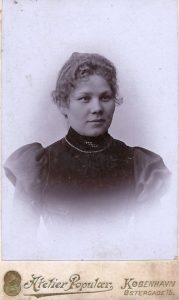
Boline Jørgine Olsen
Boline Jørgine Olsen was born May 13, 1871 in Trinitatis, København, Denmark to Morten Olsen and Ane Marie Andersdatter. She was the fifth of six children born to Morten and Ane. Her father was born in Sandjberg and her mother, Høsterkøb. Morten died when she a small child but unlike George, the family remained intact. Very little information is known, at this time, about Jørgine’s childhood. However, Jørgine’s family ties to the United States would be the catalyst for the Frederiksen’s departure from Denmark and settlement in the Cavendish-Teakean area of Idaho.
Marriage

George and Jørgine were married on January 5, 1898 and they began their married life in København. According to the Politiets registerblade George’s occupation was ‘Ølkusk,’ which loosely translates to beer driver, which is the deliveryman from the brewery to the pub, or shop. George and Jørgine remained in the city until 1906. Three of their children, a daughter and two sons, were born during this time. They appear to have returned to Høsterkøb, in 1906 and remained there until they emigrated to Idaho.
Another daughter was born in Høsterkøb on May 17, 1909. Unfortunately she was stillborn and was buried in
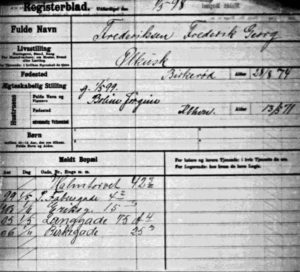
Birkerød on May 23rd.
Just two months later George and Jørgine would board the ship Hellig Olav on July 15, 1909 and begin their journey to the United States. George, Jørgine and their three children Ane, Christian, Svend arrived at Ellis Island, New York on July 27, 1909. The immigration sheet lists Uncle Johan, Cavendish as their destination.
Family Ties
Two of Jørgine’s family members had come to the United States, prior to her arrival in 1909.
Johan “John” Olsen, Jørgine’s uncle, had arrived in America in the 1870s and enjoyed success as a miner. The story that has been passed down to the family is that John found gold, while mining in the Pierce District, of Idaho and was quite wealthy. John initially purchased 160 acres of land in what was then Nez Perce County, Idaho Territory, on November 9, 1889. He also filed a claim and made final proof, via the Homestead Act, on another 153.81 acres on December 31, 1904. John Olsen, never married and had no heirs to inherit his estate.
Jørgine’s sister, Ane Margrethe and her husband Peter Sørensen had immigrated to Albert Lea, Freeborn County, Minnesota, in September of 1903.
In 1909, John would have been sixty-five years old and offered his property to his niece Jørgine and her family, if she came to Idaho.
“My wife had an uncle that kept urging us to come west, and told us what a great country this was,” Frederiksen said. “We heard so much about the United States that we decided to venture forth.”
They left Denmark in 1909 and eventually by boat, train and other conveyances landed at Peck, Aug. 2, 1909.–(Source) Lewiston Morning Tribune – August 28, 1965
The decision to come to America must not have been an easy one for George and Jørgine. Neither of them had been away from their immediate family, for extended periods of time and neither of them had much experience with life on a farm. George’s father was a frugthandler, who raised strawberries, gooseberries and vegetables and took them, by wagon, to København and sold them at the markets there. This would have been a vastly different experience from growing crops, in the wilds of Idaho. Jørgine was a “city girl,” who most likely had never spent any time farming, or ranching. Although Uncle John paid the family’s expenses to come to America, George and Jørgine sold most of their belongings, prior to coming to the U.S. It would have been too expensive to transport household goods from Denmark to their final destination, in Idaho.
After their arrival at Ellis Island, George and Jørgine made their way to Grand Central Station, to board a train west to Idaho. George would later tell his grandchildren that Grand Central Station was one of the biggest and most beautiful places he had ever seen. The family arrived at Peck on August 2, 1909:
“I remember that day it was so hot, I wanted to go for a swim in the Clearwater River. Not knowing the country or what animals you have and didn’t have, my wife was afraid there might be alligators in the river and asked me not to swim. I might add, I didn’t swim that day–but did later.”–(Source) Lewiston Morning Tribune – August 30, 1961
After 18 days of travel, in the heat of the Summer, I am sure the family was happy to finally arrive at their destination. I am not so sure a wagon ride up the old Peck Grade, in August, was all that enjoyable though.
John Olsen would die July 18, 1910 and he was laid to rest at the Teakean Cemetery. The land was transferred over to Jørgine on July 20, 1910, two days after his death.
Life at Cavendish-Teakean
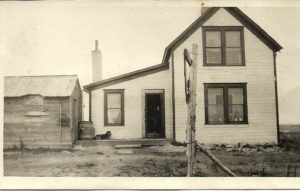
George and Jørgine’s house and property was located on what is now South Rd., between Meridan Rd. and Brown Rd. The property was adjacent to the homestead of Moses Magid. According to Frank Carey Jr., John and Moses were friends and worked together, farming their tracts of land. Moses died in a tragic accident in 1911 and is buried in John Olsen’s plot, at the Teakean Cemetery.
George and Jørgine settled into the community, forged friendships and made a life for themselves, in their new home. However, their life was not without hardships and tragedy. On June 13, 1912 and on October 27, 1914; infant daughters were stillborn to the couple; both are buried at the Teakean Cemetery. Sometime in 1914, it was discovered that their daughter, Ane Elisabeth, had a brain tumor. Jørgine and Ane traveled to the Mayo Clinic, for treatment and appear to have spent some time, or perhaps stayed with Jørgine’s sister, Ane Margrethe and family, during Ane’s treatments.
“Valley City North Dakota, June 15
My dear Cousin
Our best wishes on a happy birthday from us all. Pleas [sic] send some words soon we are anxius [sic] to know how Aunty get long [sic]. Our best regard [sic] to your all from Papa and Mama.
Your Cousin
Svend Sorensen”
(Source)–Photo Album of F. George Frederiksen – provided by Rod Frederiksen
The above note was sent to Ane from her cousin Svend Olaf Sørensen, it was most likely written in 1914. If so, Svend would have been about ten years-old, when he wrote this note, to his cousin Ane. The note does not give the reason, or cause, for the concern regarding Jørgine’s situation. If the note was written in June of 1914, Jørgine would have been forty three years old, five months pregnant with her sixth child and possibly having complications. This along with Ane’s illness and traveling for treatment, had to have weighed heavily upon Jørgine and the rest of the family. George and the boys, Chris and Svend, stayed behind, at the homestead, while Ane was receiving treatment at the Mayo Clinic. George appears to have hired someone to cook for them, while they were batching it:
“Rochester Minn
Dear Anker,
how is the new cook is [sic] is she very cranky about wood and water How is M. K. or is she home yet ask Svend how the blackhaired [sic] girl is
Anna”
Postcard from Ane to her brother Christian Anker Frederiksen – Mailed from Rochester Minnesota on February 6, 1915 — (Source)–Photo Album of F. George Frederiksen – provided by Rod Frederiksen
M. K. is probably a reference to Mildred Mae Kight, the daughter of Albert and Zetella (Roup) Kight, she would have been close in age to Ane. I have no idea who the black haired girl might have been but it wasn’t Svend’s future wife, Wanda Marie Daniels, she was not born until December of 1917.
There is one more postcard that has been found, in George’s photo album and it appears to be from a fellow patient and friend Ane met at the Mayo Clinic. The name appears to be Ethel Toban, or Tobin:
Waverly, Ia
Dec 24,
Dear Friend, Have been to Rochester again they can’t do anything more for me so will go back to Dak. Jan 1st.
How are you. Pleas [sic] write to me & tell me all about yourself & mother. My mother sends her best regards to your mother & yourself.
Postcard from Ethel to Ane Elisabeth Frederiksen – Mailed from Aredale, Iowa on December 26, [year illegible] — (Source)–Photo Album of F. George Frederiksen – provided by Rod Frederiksen
It isn’t known how many trips, or the length of time, Jørgine and Ane spent in Minnesota but they probably made several trips, due to the nature of Ane’s illness.

Despite the hardships of frontier life, the family enjoyed the friendship of neighbors and were active in their community. George was a charter member of the Evergreen Grange No. 374.
The rural communities of Cavendish and Teakean in the early 1900s were close knit and families would frequently team up to expedite farming activities, or lend a hand if someone was ill. They would gather together and attend church services, have Sunday dinners, picnics and sometimes dances. When someone traveled to a far away place, such as Orofino, it was considered newsworthy and often made the local paper. By all accounts George was highly

respected for his work ethic and integrity. One example of his determination is the road he dug out by hand, with only a shovel, to the family home. Anyone from the area knows there is a high clay content in the soil and digging in it is a challenge, under the best of circumstances. Remnants of this road, on the south side of South Rd., can still be seen today. Another account of his tenacity and perhaps his frugal nature are evidenced in the following story, told by J. Lowell Huffman:
They were cutting brush and piling it to be burned. Everyone else had leather gloves on, but George had his gloves in his pocket and his hands were taking a beating. Someone asked him why he didn’t put his gloves on. He said, “The skin on my hands will grow back, the gloves won’t.” — (Source) Doug Huffman as told by his father, J. Lowell Huffman
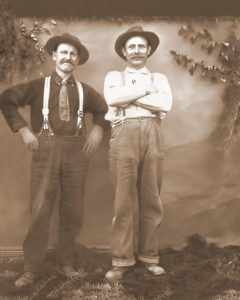
Ada (Carey) Pitcher once told me that the Frederiksen and Carey families would often go for wagon rides on Sunday afternoons. According to her if they met another traveler, during their ride, Frank Sr. and George would prank the stranger by acting as if one of them were crazy. This delighted the children but the wives were somewhat embarrassed by the men’s antics. Throughout his life George was known for his sense of humor and practical jokes. One story is how he was roofing “his house” and broke both of his heels. Versions of this story appeared in the Lewiston newspaper commemorating his 87th and 91st birthdays.
“Frederiksen has been described as an “independent fellow.”
When he moved to Ahsahka in the 1950s he decided to roof his house. Feeling himself slipping one day as he was working on the roof, he jumped to the ground. He broke both heels in the fall and was in casts for six months.
But Frederiksen wouldn’t stay in the hospital long and soon was walking with canes insisting that he could take care of himself.”–(Source) Lewiston Morning Tribune – August 28, 1965
The story that was passed down in the family is that after he retired and moved from Cavendish-Teakean, to Ahsahka, he was helping his neighbor Eunice (Mapes) Carey and it was actually Eunice’s roof that needed mending. While he was on the roof, removing the shingles, George decided to prank Eunice. He called out to her and when she came outside to see what he needed, he proceeded to dance a jig on top of her roof, he lost his balance and took a tumble. Somehow he managed to right himself in midair and landed firmly on his feet, breaking both of his heels, upon impact. George was in his eighties when the accident happened.
In 1916 another tragedy would forever change George’s life. Jørgine was pregnant with their seventh child, a boy, on September 30th she gave birth and both she and the infant died. According to the death certificate the baby was in the breech position and stillborn, Jørgine succumbed to shock. George buried his wife, with their infant son, in her arms, at the Teakean Cemetery.
“Frederiksen, Boline Jørgine Olsen, born in Copenhagen, Denmark, May 13, 1871, died Sept. 30, 1916, near Lenore, Idaho. Jan. 29, 1898, she was married to Frederik George Frederiksen. To this union seven children were born, four dying in infancy. Mr. Frederiksen, one daughter and two sons survive. She was a member of the Lutheran church. Services in the Clear Water church, near Teakean, Idaho, by the writer. Text, Heb. 12:22. She was laid to rest with her newborn babe in her arms, in the cemetery near the church. –James Harp, Lenore, Idaho.–(Source) The Gospel Messenger – October 28, 1916
Not only did George lose his wife and infant son, his daughter Ane was still battling cancer. George was now a single parent of three, with a farm to run and medical bills to pay. In 1918, after Jørgine’s death,

George sold his farm to Josiah Goin and moved to Clarkston, Asotin County, Washington and lived there for a time, probably to seek treatment for Ane. George’s youngest son Svend stayed in Cavendish and boarded with the Carey family, oldest son Chris, along with George and Ane went to Clarkston. On George’s WWI draft registration, dated September 12, 1918, he listed his address as Clarkston and Ane as his nearest relative. Ane’s illness had progressed to the point the tumor was altering her features and probably caused great pain, for her. According to Ardis (Carey) Lansing, toward the end of Ane’s illness her eyes protruded due to the pressure from the tumor. On June 6, 1919, Ane died, in Spokane.
“Frederiksen, Ane Elisabeth, daughter of Georg and Jørgine Frederiksen, born in Copenhagen, Denmark. She came to America with her parents in 1909. She died at the hospital at Spokane June 6, 1919, aged 20 years. She leaves her father and two brothers. Her mother, three sisters and one brother preceded her. Services by the writer, assisted by Bro. Chas. M. Yearout. –James Harp, Lenore, Idaho.”– (Source) The Gospel Messenger – June 28, 1919
George would travel back to Denmark and visit family not long after Ane’s death. In August of 1919 both he and son Svend applied for passports. George’s plan was to visit family and stay about a year. Svend decided not travel to Denmark, he stayed in Idaho and most likely boarded with the Carey family.
When George returned from Denmark he continued farming in the Cavendish-Teakean area until his retirement in 1945, when he moved to Ahsahka.
Throughout his life George stayed in touch with the family in Denmark. The exception was during WWII, when Denmark was invaded and occupied by Hitler’s Germany.
“George Frederiksen has received the first letter in five years from his people in Denmark. During the five years, two of his brothers have died. According to the letter received by Mr. Frederiksen, times are bad in Denmark. They have had no coffee nor tobacco in five years and no coal for the winter ahead.”–(Source) Clearwater Tribune – October 11, 1945
The brothers mentioned in the above article were his older brother Jørgen Peder and his youngest brother Edvard Vilhelm. I am in touch with descendants of Jørgen Peder but have no futher information on Edvard Vilhelm’s family.
In 1957 he moved to Orofino and lived with his son Chris and family at 202 B Street.
Family Patriarch
The house at 202 B Street had a small “guest house” behind it that we referred to as the “little house.” This is where George set up his living quarters, there was a roll top desk, bed and what seemed like hundreds of pictures and photographs, covering the walls, mostly of family. Between the main house and his little house, he always planted a vegetable garden. George was an avid gardener and his was always a pristine garden completely devoid of weeds. His grandson Clinton told stories of how George would weed his garden by bending at the waist, without squatting, or stooping to pluck the weeds, a tribute to his nimbleness and agility. George also maintained a beautiful hedge around the house on B Street.
George maintained his quick wit and continued to delight in playing pranks whenever the opportunity presented itself.
My favorite story has to be when he had a foot race with his grandson, Clinton. Schuyler Carey and Dad were both talking about this one time and chuckling. “George looked like an old man to most people and was starting to move a little slower. He told his grandson Clinton he would buy him a new bicycle if Clinton could beat him in a footrace. I don’t know how old Clinton was, but he was bursting with confidence that he could beat his old grandpa. George proved to be very spry for his age as he ran off and left Clinton behind. Clinton was absolutely crushed, but Grandpa George bought him a new bicycle anyway.”– (Source) Doug Huffman as told to him by his father, J. Lowell Huffman and cousin Schuyler Carey

When I was a child I remember going to town, Orofino, with my mom and when we went to IGA I would beg for a bag of candy “because Grandpa George needed it.” If I succeeded, which I usually did, this was a double win, first of all I got candy and secondly I got to see Grandpa George.
We would finish shopping and go to Uncle Chris and Aunt Reta’s house and I would run in carrying the bag of candy, to see Grandpa George. Aunt Reta and Mom would say “that is for after dinner” and both Grandpa and I would nod our heads in agreement. With the formalities out of the way, we would set about with our routine. I would take Grandpa’s hand and we would go to his “little house,” where in one of the cubbies, of the roll top desk, he kept chocolate bars for me. He would make me promise that I would eat all of my dinner, if he gave me candy and then swear me to secrecy, not to tell anyone, he had given me chocolate. I of course promised to clean my plate and under no circumstances would I tell on Grandpa, for giving me chocolate. We would chat for a while, while I consumed the entire chocolate bar, then go back to the main house. Uncle Chris would arrive home, from his job as Clearwater Sheriff, my Dad would join us and we would all sit down for dinner. I remember sitting in the “tall chair” at the table with a plate of food in front of me and it wouldn’t be long before the inquisition would start.
Grownup: “Why aren’t you eating your dinner?”
Me: “I am eating.”
Grownup: “Don’t just drink milk, you need to eat.”
Then the raised eyebrows and the bombshell question.
Grownup: “Did you have candy, before dinner?”
Me: “No.”
Grownup: “Did grandpa give you a candy bar?”
Me: “No, Grandpa George didn’t give me a candy bar.”
All heads would then turn toward Grandpa George.
Grownups, in unison: “George, are you teaching that child to tell stories?”
Grandpa would shake his head no and give me a wink.
Grandpa George smoked a pipe and to this day I love the smell of pipe tobacco, which, to me, smells like chocolate and always makes me think of Grandpa.
After I moved to Nebraska, I wrote to Grandpa George, with my mom’s help, and ask him to teach me to speak Danish. Grandpa wrote back that he would be happy to teach me how to speak Danish and we would start when I came to visit, the following summer. When I returned for the summer, Dad took me to see Grandpa George and we followed our routine. This time he had Nestle Crunch candy bars waiting for me, in the cubby. It would be my last visit with Grandpa, he passed away shortly after that.
George Frederiksen died on June 15, 1967, at the age of 92, in Orofino. When he passed away only one of his children was still living, his son Chris. He had outlived his wife and six of his seven children. His lasting legacy to his family is his strength and tenacity to persevere, while maintaining a sense of humor. Perhaps the best gift he gave us all is the, now infamous, twinkle in our eyes we Frederiksen descendants get, when we’re up to something mischievous.
Note: A special thanks to Rod Frederiksen and Doug Huffman for their help, support and contributions to this post and this website! ~Jo


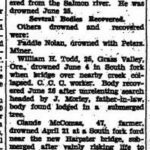



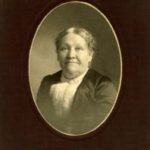

Thank you so much Jo, for telling your family’s story. I was surprised to find from Doug’s research that these families had all arrived at Cavendish about the same time. The Fredricksons, Browns, Careys, Huffmans.
For years all of these close friends of our great grandparents and grandparents were in our family photos, now we are able to enjoy knowing them as well.
Hi Cathleen, it is good to hear from you! I am glad you are enjoying the posts and now that I have an overview of my family done, I am hoping to write about the other families who came to the Cavendish-Teakean area.
Hallo jo in Denmark i have the same foto of jørgine on my Wall
Hi Pia,
Thank you for contacting me and I have sent you an email. I am very interested to know how you are related to my great-grandmother’s family. I have found a sister of Jørgine’s who came to America and settled in Albert Lea, Minnesota, we were unaware of this until a couple of years ago. Here is the list of brothers and sisters I have:
Children of Morten Olsen and Ane Marie Andersdatter:
I. Oluf Christopher Olsen was born in Sokkelund, København, Denmark, on December 8, 1862. He was baptized in Vor Frue Kirke, Sokkelund, Kobenhavn, on February 1, 1863. The Church of Our Lady is the cathedral of Copenhagen and the National Cathedral of Denmark. It is situated on Vor Frue Plads and next to the main building of the University of Copenhagen.
II. Ane Christine Matilde Olsen was born in Denmark about 1865. Ane Christine Matilde Olsen married Herman Kleindenst. They have one daughter: Bertha. Herman Kleindenst was born in Denmark. They have one daughter: Bertha. Herman Kleindenst was born in Denmark.
III. Anker Jens Andreas Olsen was born in Kobenhavn, Kobenhavn, Denmark, about 1867.
IV.Ane Margrethe Olsen was born in København on February 27, 1869.
She was baptized in Trinitatis, Kobenhavn, on July 25, 1869. At the age of 31, Ane Margrethe Olsen married Peter Sorensen on Friday, May 25, 1900, in København, Kobenhavn, Denmark, when he was 33 years old. They had two children: Svend and Kathryn. Peter Sorensen was born in Jutland on Friday, April 26, 1867. Ane Margrethe lived in 1910 at Marital Status: Married; Relation to Head of House: Wife in Valley City Ward 4, Barnes, North Dakota, USA. She also resided in 1920 at Marital Status: Married; Relationship: Wife in Albert Lea, Freeborn, Minnesota. Ane Margrethe was living in 1930 at Marital Status: Married; Relation to Head of House: Wife in Albert Lea. She lived in 1935 in Albert Lea, Freeborn, Minnesota. Ane Margrethe also resided on April 1, 1940, at Marital Status: Married; Relation to Head of House: Wife in Albert Lea, Freeborn, Minnesota, USA. She died in Harlan, Shelby, Iowa, on February 8, 1962, at the age of 92.
V. Boline Jørgine Olsen was born in Trinitatis, København, København, on May 13, 1871. She died in Teakean, Clearwater, Idaho, on September 30, 1916, at the age of 45.
VI. Benthine Mathea Olsen was born in Trinitatis on April 19, 1874. She was christened in Trinitatis, København, on July 26, 1874.
Thanks again for contacting me and I look forward to hearing from you soon and sharing information!
Jo